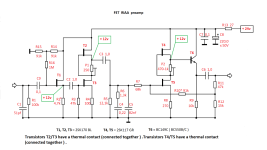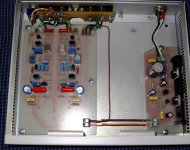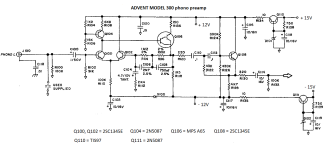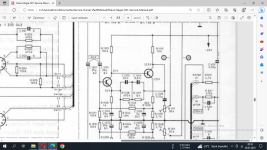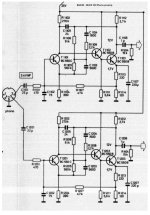A scheme with a passive RIAA . But not the simplest scheme . Transistors should be selected in pairs . This circuit gives a good sound . It 's better than Le Pacific .
The scheme from the publication Elektor ( 2004 , No. 1 ) is taken as a basis . I changed the original circuit - changed the T1 bias circuit , and applied other transistors .
The photo shows my version of the scheme . I built this preamp 2 years ago .
The scheme from the publication Elektor ( 2004 , No. 1 ) is taken as a basis . I changed the original circuit - changed the T1 bias circuit , and applied other transistors .
The photo shows my version of the scheme . I built this preamp 2 years ago .
Attachments
Last edited:
Long time ago i built metaxas phono pre, worked ok.
http://www.metaxas.com/pages/technology/diy.html
http://www.metaxas.com/pages/technology/diy.html
Opamps have transistors inside, you know...Please tell me are discreet phono stages better than ones with op amps?
Or is this a myth?
You must be right, bacause i have no idea what are you talking about.
Please post riaa schematics with hoeffelman and meyers configuration.
Please post riaa schematics with hoeffelman and meyers configuration.
See the links in post #23, https://www.diyaudio.com/community/threads/simple-transistor-based-riaa.401265/post-7408155
The original Hoeffelman and Meys circuit has no RIAA correction, but the variant that is figure 5 in the 2003 Electronics World article has.
The original Hoeffelman and Meys circuit has no RIAA correction, but the variant that is figure 5 in the 2003 Electronics World article has.
Ok i believe you.
Here is many more simple riaa
https://www.diyaudio.com/community/threads/discrete-phono-stage-single-supply.255309/
Here is many more simple riaa
https://www.diyaudio.com/community/threads/discrete-phono-stage-single-supply.255309/
This may be of interest too...
https://www.diyaudio.com/community/threads/turntable-fun.330470/#post-5625191
https://www.diyaudio.com/community/threads/turntable-fun.330470/#post-5625191
When I asked my local Audio guru this question he told me there is no such thing as better in the audio world.Please tell me are discreet phono stages better than ones with op amps?
Or is this a myth?
You have the lab values and then you have the ear values. If you fill a room with 10 guys and 10 amps and ask each one to rate the amps in order of 1-10 no 2 guys will agree on the same ranking.
If you latter start to technically analyze the amps. You will find that there are amps with lousy performance numbers i.e. poor channel separation high noise that are hot favourites.
Im talking about regular pheasants like me. Not audiophiles. That make up a very tiny percentage of music lovers.
His advice to me. Build a few circuits see what you like and then narrow it down purely by ear.
Im a technical guy so I do like to measure stuff.
My take. Its all down to what kind of music you were exposed to as a kid. In my case our family got its first decent music system in 79. It was an Akai Tape spool, cassette deck, amp and a Hitachi HT 350 turntable. The turntable is the only item we still have. The Amp was a AM-2400. Im just trying to recreate that sound. The closest I have come to it is on the woodstock SA4000 Amp I revived from a junkyard. Its a simple quasi complementary design which uses 2n3055HV as the final drivers.
It produces a clean nice sound to my ears. And for sure beats all the other designs I have tried so far. Like Chip amps, STK Amps, class D etc. Only thing missing in this amp is a phono section. I mean it has a full board dedicated to Phono but it only does the amplification no RIAA.
Hello !Please tell me are discreet phono stages better than ones with op amps?
Or is this a myth?
About 25-30 years ago I used phonopreamps on microchips . These were chips of the 071 , 5534, 604 series , as well as some manufactured in the USSR ( K544 / K574/ K504 and others ) .
But I like the sound of circuits on discrete transistors more .
I have about 10 phonopreamps on transistors , and I don 't want to go back to microchips .
But someone else might disagree with my opinion.
I have 6 Tone control boards. From 6 different vendors. They all use opp amps. And they all sound like ****. I tried changing the op amps used didn't help at all. I tried changing the power supplies didn't help either. I guess I could clean up the signal by adding some caps. The Rockola board uses a 10 PF cap on the last opamp that seems to help a lot. But what I didn't like was that say your playing a 10K signal. You then change the bass. Knob.
Technically it should have zero impact on the signal but when you check it does impact the signal.
On the transistors amps I don't have this problem.
The best tone control board I have is in the woodstock it uses 2 x to92 bc149c transistors and a few caps. And it sounds and works amazing. Ok to be fair Id like a little more bass. But that can be worked out.
Say I cant find the BC149c whats the closest replacement sound wise. Tech spec wise I see there are tons of options. Maybe Im just addicted to that 70s sound. Like many guys are hooked to valves.
Technically it should have zero impact on the signal but when you check it does impact the signal.
On the transistors amps I don't have this problem.
The best tone control board I have is in the woodstock it uses 2 x to92 bc149c transistors and a few caps. And it sounds and works amazing. Ok to be fair Id like a little more bass. But that can be worked out.
Say I cant find the BC149c whats the closest replacement sound wise. Tech spec wise I see there are tons of options. Maybe Im just addicted to that 70s sound. Like many guys are hooked to valves.
Interesting. When it comes to tone control, they typically use very strong feedback to achieve it. Could be the reason. Try to use cello palette style tone control, parallel filters, sounds way better. Like old SAE or modern Schiit loki. Read all about it here.
https://www.diyaudio.com/community/...e-eq-design-was-high-end-tone-control.209644/
I have small schiit loki mini, it uses discrete classA buffers, parallel filters with inductors, runs very hot, sounds great. Schematics not available.
Otherwise i have three behringer ultracurve 31band digital eq, totally different beast.
https://www.diyaudio.com/community/...e-eq-design-was-high-end-tone-control.209644/
I have small schiit loki mini, it uses discrete classA buffers, parallel filters with inductors, runs very hot, sounds great. Schematics not available.
Otherwise i have three behringer ultracurve 31band digital eq, totally different beast.
Now this is oftopic, but this thread does not really has clear goal anyway, so i will mention it again.
I find normal baxandall tone control with plus bass and plus treble utterly damaging. If you look at the filter curves, they start in the middle of the audio spectrum, 1kHz, and first smoothly, then more abruptly add the gain. Flatten at the ends of spectra, 20Hz and 20kHz.
If you have small booshelf, like many people, which, if properly designed, schould be relatively flat between 50Hz and 10kHz, you only need to add bass below 50Hz.
But add max baxandall, yes, you add some bass below 50Hz, but you will create terrible midbass hump around 100Hz. Now it will sound boomy and muddy.
Same thing applies to highs, creating nasty sounding upper mid shout.
You wanted to improve something, but you made things worse. Baxandall is just too crude, because it starts at 1kHz. Instead, it should be starting only at 100Hz for bass or 10kHz for highs respectively.
It should be parametric. And many better preamps are. Sanyo plus, for instance.
Tone controls can be very damaging, if not done right. One needs either parametric control, not only plus/minus, but turnover frequency too, and ideally q of the eq as well, that is how narrow or wide the band is. Now its so complex, that digital eq makes more sense.
I find normal baxandall tone control with plus bass and plus treble utterly damaging. If you look at the filter curves, they start in the middle of the audio spectrum, 1kHz, and first smoothly, then more abruptly add the gain. Flatten at the ends of spectra, 20Hz and 20kHz.
If you have small booshelf, like many people, which, if properly designed, schould be relatively flat between 50Hz and 10kHz, you only need to add bass below 50Hz.
But add max baxandall, yes, you add some bass below 50Hz, but you will create terrible midbass hump around 100Hz. Now it will sound boomy and muddy.
Same thing applies to highs, creating nasty sounding upper mid shout.
You wanted to improve something, but you made things worse. Baxandall is just too crude, because it starts at 1kHz. Instead, it should be starting only at 100Hz for bass or 10kHz for highs respectively.
It should be parametric. And many better preamps are. Sanyo plus, for instance.
Tone controls can be very damaging, if not done right. One needs either parametric control, not only plus/minus, but turnover frequency too, and ideally q of the eq as well, that is how narrow or wide the band is. Now its so complex, that digital eq makes more sense.
I do have bugle2, which sports 3 opamps, and will likely sound way better than most of the simple transistor based riaa posted in this thread.
The simple phono preamplifiers are full of electrolytic capacitors. Those are problematic in multiple ways. The designs are from the time when transistors were expensive.
A good preamplifier takes more than two transistors. Transistors are nearly free on ICs and still inexpensive in discrete form today.
Ed
A good preamplifier takes more than two transistors. Transistors are nearly free on ICs and still inexpensive in discrete form today.
Ed
The RIAA stage of BRAUN's Regie 501 uses also a 2-transistor topology (go to the attachment), but slightly different in some details - especially the use of R1102 (100K bootstrap resistor). The effect is nearly the same as the use of a FET instead a BjT input transistor.A couple of schemes of 2-transistor topology. The second transistor is Darlington .
Under
https://radio-bastler.de/forum/showthread.php?tid=19414
some images of this model and unter
https://elektrotanya.com/braun_regie_501_k_sm.zip/download.html
you will find the service manual.
Sound is very good in refurbished condition.
Attachments
- Home
- Source & Line
- Analog Line Level
- Simple Transistor based RIAA
